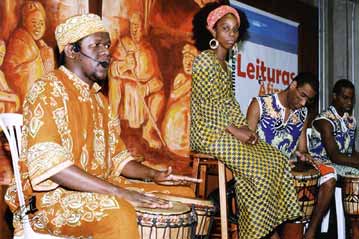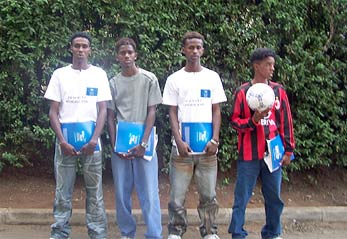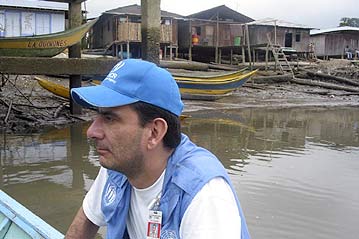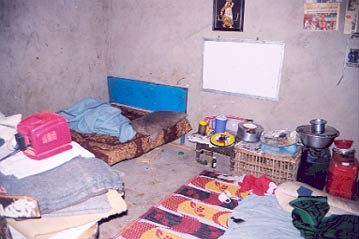Colombians, fleeing war, make a slice of Ecuador their own
Colombians, fleeing war, make a slice of Ecuador their own

SANTO DOMINGO DE LOS COLORADOS, Ecuador, October 17 (UNHCR) - They were static-filled and hard to hear, but the radio signals nevertheless carried a powerful message: Come here, to this little town, with its one unpaved road, and make it grow.
Back then, in the 1950s, Santo Domingo de los Colorados was just one more dot in Ecuador - a tiny place in a tiny country. What Holger Velastegui, the owner of a small radio station, wanted was to put it on the map. So from the studios at Radio Zaracay, he would hold forth - telling listeners that the land was rich and the people were good, urging those with a dream to come.
Many from all over Ecuador did. But setting the stage for the transformation of this town decades later, so did small farmers and shopkeepers from the hamlets of southern Colombia who were fleeing a conflict so bloody that it was known as La Violencia.
Now, with Colombia's seemingly never-ending war entering a new phase that promises more violence, a growing number of Colombians are abandoning their homes, UN officials say. Most escape violence-scarred villages for shantytowns in Colombia's biggest cities. A growing number, though, are fleeing to neighbouring countries, with unknown numbers headed here to this city of nearly 300,000 in the foothills of the Andes.
But Santo Domingo, a jarring, seven-hour drive from the Colombian border via hair-pin roads along mountain passes, is not a border town like Lago Agrio, a notorious Ecuadorian honky-tonk where cantinas and bordellos attract Colombian guerrillas and paramilitary fighters. Nor is it like the sweltering, makeshift border towns Colombian refugees flock to in Panama or Venezuela.
Instead, Santo Domingo, with its scores of Colombian businessmen, landowners and labourers, offers newcomers a peaceful, welcoming refuge that makes it as easy as is possible for a refugee to assimilate.
This is a place, after all, where Colombia's folkloric Vallenato music blares from bars, and where restaurants serve succulent stews and steaks from the cuisine-rich city of Medellín. It is a town so Colombian, in fact, that across Ecuador it is known not by its proper name - inspired by the local Indian tribe known as the Colorados - but rather as Santo Domingo de los Colombianos.
"I had heard all about this place, even in my little town back home," explained a man who recently fled a violence-plagued hamlet in southern Colombia with his wife and three daughters. "Travelling businessmen had talked about it. We knew people who lived here. Everybody said it would be good."
The number of people uprooted in Colombia is huge, now numbering 2.7 million, up from 2 million just two years ago, according to the Consultancy for Human Rights and the Displaced, a Colombian group that tracks the displaced.
It is unclear how many are crossing the frontiers in search of refuge, since most people never register with authorities. But grimy border towns are brimming with refugees in Venezuela and Panama, and the Ecuadorian Migratory Police estimated that 210,000 Colombians entered this country in the last two years and never returned home.
"This conflict is, every day, expelling more and more people," said Maria Virginia Trimarco, who oversees operations in the regions for the UN High Commissioner for Refugees.
The migration of people has strained services in resource-poor border communities and fanned fears that Colombia's conflict is spilling over into once-peaceful regions. That has irked officials in some of Colombia's neighbouring countries.
In Panama, the Ministry of Government and Justice recently criticised the UN and foreign aid groups for assisting Colombian refugees the government said committed crimes in Panama. And in Venezuela, the government continues to refuse giving legal status to refugees, implying that those crossing in are not fleeing conflict.
Ecuador has been the most open to the newcomers, since it is the only country bordering Colombia that regularly offers refugee status to Colombians, giving those who are accepted a work permit and temporary residency. Now, more than 600 a month are applying as refugees, up from about 150 in January.
But Fabián Valdivieso, who oversees human rights issues for the foreign ministry in Quito, said that as the "avalanche" of Colombians into his country continues, resentments will surely increase. Already, some Ecuadorians blame rising crime on Colombians, and rights groups increasingly report cases where Colombians are manhandled by local police.
Even Santo Domingo, officials and businessmen here say, may soon feel the strain of Colombia's conflict, exacerbated by Ecuador's own economic troubles.
"Things are a bit harder now because the country is going through a time of job shortages," said Mr Velastegui, now 68 and a former mayor. "Now it is not the same. We do not have the same opportunities as before."
This country, with its deeply rooted poverty and traditionally unstable governments, is clearly the most vulnerable in the region to the effects of Colombia's conflict. That has prompted President Gustavo Noboa's government to press for more American aid while emphatically stressing that Ecuador will remain neutral in Colombia's conflict.
Geopolitics, though, seems to have little urgency here in Santo Domingo. This city, carved from a cloud forest, is now an amalgam of multi-coloured cinderblock homes, busy roundabouts and bustling streets packed with stores and repair shops. It is poor and dusty, but for many Colombians this city has been a welcome relief from the violence and tumult of their hometowns. The fact that so many Colombians live here - the Colombian consulate reports 10,000 have registered, but many officials here believe the number could be in the tens of thousands - makes it easier on newcomers.
"Most Colombians are here, and the ones in Colombia know that, so they come here to find a piece of Colombia, a piece of their land," said Janeth Guaycha, a Catholic Church worker who recently began registering refugees in Santo Domingo under contract with the UN. "They say to themselves, 'Maybe I have a friend who can help.'"
One man who fled from a town outside the city of Cali just a few months ago has already set up a restaurant. A fellow Colombian he met here loaned him $800 to buy kitchen appliances and the four tables he needed to set up.
"It is like you do not miss your country here," said the restaurant owner, who had come to avoid extortion payments levied by rebels. "All the people I know here, we are so close and we have shared everything together."
As part of this close network, the more established Colombians often offer jobs to the new arrivals. Such attitudes clearly make life easier for the newcomers, but for some of them, life remains hard.
One man, who left southern Colombia after armed groups threatened to recruit his sons, said he does not make enough money to send his children to school. He also worries that the rebels, who are known to cross frontiers, could soon come here.
Mayor Kleber Paz y Miño discounts such concerns, saying there has been no sign of trouble. He welcomes the Colombians, saying most are determined to come here and work. "No one comes holding out his hand," he said. "They come here, put their head down and go to work, looking for a future."
* This is the longer version of an article that first appeared in the New York Times in October 2002
By Juan Forero






